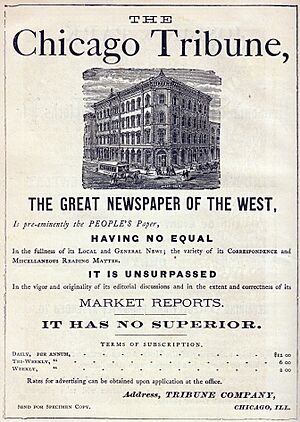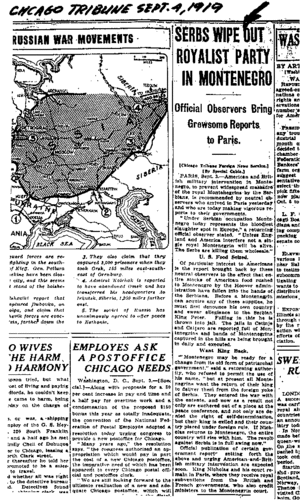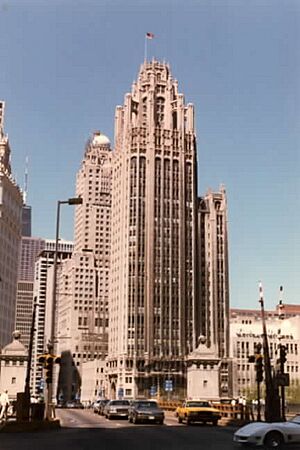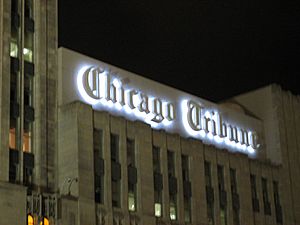Chicago Tribune facts for kids
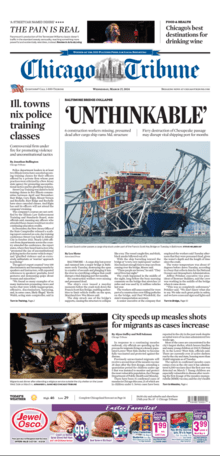
The front page of the Chicago Tribune on March 27, 2024
|
|
| Type | Daily newspaper |
|---|---|
| Format | Broadsheet |
| Owner(s) | Tribune Publishing |
| Founder(s) |
|
| Founded | June 10, 1847 |
| Language | English |
| Headquarters | Freedom Center (Chicago) |
| Country | United States |
| Circulation | 73,000 Average print circulation |
| ISSN | 1085-6706 (print) 2165-171X (web) |
| OCLC number | 7960243 |
The Chicago Tribune is a daily newspaper from Chicago, Illinois, in the United States. It started in 1847. For a long time, it called itself the "World's Greatest Newspaper." This slogan even inspired the names of its old radio and TV stations, WGN. It is the most-read newspaper in the Chicago area and the Great Lakes region. It is also one of the largest newspapers in the United States by how many copies it prints.
In the 1850s, under Joseph Medill, the Chicago Tribune became very supportive of Abraham Lincoln. It also backed the new Republican Party. Later, in the 20th century, under Robert R. McCormick, the paper was known for promoting American conservative ideas. It also spoke out against the New Deal government programs. The newspaper's stories and opinions reached many places outside Chicago. This was thanks to its connections with the New York Daily News and the Washington Times-Herald. For much of the 20th century, it had reporters all over the world. In the 1960s, its owner, Tribune Company, started buying more newspapers. In 2008, for the first time ever, the Tribune supported a Democrat for U.S. president. This was Barack Obama, who was a U.S. senator from Illinois.
The Tribune used to be printed only in a large size called broadsheet. In 2009, it tried printing a smaller size, called tabloid, for sales at newsstands. However, readers did not like this change. So, in 2011, the Tribune went back to printing only in the broadsheet size for all its copies.
The Tribune was owned by Tribune Publishing. In May 2021, Alden Global Capital bought Tribune Publishing. Since then, the newspaper has focused more on news from Illinois and the Chicago area. It covers less national and international news. The Tribune has also faced lawsuits about its billing practices.
Contents
History of the Chicago Tribune
Early Years: The 1800s

The Tribune was started by James Kelly, John E. Wheeler, and Joseph K. C. Forrest. Their first newspaper came out on June 10, 1847. Over the next eight years, the paper had many different owners and editors. At first, the Tribune did not support any specific political party. But it often favored the Whig or Free Soil parties.
Around 1854, Joseph Medill became the managing editor. Under his leadership, the Tribune became the main newspaper in Chicago for the Republican Party. The Tribune also bought out other Chicago newspapers. These included the Free West in 1855, the Democratic Press in 1858, and the Chicago Democrat in 1861. Between 1858 and 1860, the paper was known as the Chicago Press & Tribune. On October 25, 1860, it became the Chicago Daily Tribune. Before and during the American Civil War, the new editors strongly supported Abraham Lincoln. Medill even helped Lincoln become president in 1860. The paper also pushed for the end of slavery. It remained important in Republican politics for many years.
In 1861, the Tribune published new lyrics for the song "John Brown's Body". Medill later served as mayor of Chicago after the Great Chicago Fire of 1871.
The 1900s: Growth and Changes
In the 20th century, Colonel Robert R. McCormick took charge in the 1920s. The paper was very focused on American issues and had a conservative view. It used the slogan "The American Paper for Americans." From the 1930s to the 1950s, it strongly criticized the Democrats and the New Deal programs.
When McCormick became co-editor in 1910, the Tribune was the third most popular paper in Chicago. It had a circulation of 188,000 copies. McCormick and his cousin, Joseph Medill Patterson, added new features. These included advice columns and comic strips like Little Orphan Annie. They also pushed for political changes. By 1914, they had made the Tribune more popular. In 1919, Patterson left to start his own newspaper, the New York Daily News, in New York City.
In 1922, the Tribune held a lottery to attract more readers. It won this competition, adding 250,000 new readers. That same year, the Chicago Tribune held a worldwide design contest for its new building, the Tribune Tower. This contest was a great way to get publicity. More than 260 designs were submitted. The winning design was a neo-Gothic style by architects John Mead Howells and Raymond Hood.
The Tribune was also a leader in radio. It bought an early radio station, WDAP, in 1924 and renamed it WGN. The letters WGN stood for "World's Greatest Newspaper." WGN Television started on April 5, 1948. These stations stayed with the Tribune for 90 years.
The Tribune's sports editor, Arch Ward, created the Major League Baseball All-Star Game in 1933. This was part of Chicago's Century of Progress fair.
One of the Tribune's biggest news stories was when it got the full text of the Treaty of Versailles in June 1919. Another big story was its report on U.S. war plans before the Pearl Harbor attack. On June 7, 1942, the Tribune announced that the United States had broken Japan's naval code. This was a secret military operation. President Franklin D. Roosevelt was so angry that he thought about shutting down the Tribune.
Under McCormick, the Tribune also tried to simplify English spelling. Starting in 1934, the paper changed the spelling of many common words. For example, it used "altho" instead of "although" and "thru" instead of "through." Most of these simplified spellings were used until 1975.
The 1948 Presidential Election Headline
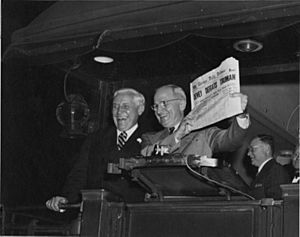
The paper is famous for a big mistake it made during the 1948 presidential election. Many people, including the Tribune editors, thought the Republican candidate Thomas Dewey would win. An early edition of the next day's paper had the headline "Dewey Defeats Truman". But Democrat Harry S. Truman actually won. Truman famously held up the newspaper with the wrong headline in a picture.
After McCormick passed away in 1955, the Tribune started to report from a wider point of view. While its editorials remained conservative, its news reporting became less biased.
In 1974, the Tribune published the full text of the Watergate tapes. This was a huge journalism achievement. The paper printed the 246,000-word text in a special 44-page section. It came out just 24 hours after the White House released the transcripts. The Tribune was the first newspaper to publish them. After reading the transcripts, the paper's editorial board called for President Nixon to resign. This was a big deal because the Tribune had been a longtime supporter of Nixon.
In 1975, a columnist resigned from the paper due to issues with his writing. In 1978, the Tribune hired columnist Bob Greene from the Chicago Sun-Times.
The Tribune won 11 Pulitzer Prizes in the 1980s and 1990s. These awards recognize excellent journalism. Winners included cartoonists Dick Locher and Jeff MacNelly, and writers like Jack Fuller, Jeff Lyon, Peter Gorner, Dean Baquet, William Gaines, Ann Marie Lipinski, Lois Wille, Clarence Page, Ron Kotulak, R. Bruce Dold, Paul Salopek, and Blair Kamin.
In 1982, the Chicago Tribune opened a new printing facility called Freedom Center. In 1984, the Tribune hired popular columnist Mike Royko from the rival Sun-Times.
In 1986, film critic Gene Siskel changed his role at the paper. He became a freelance writer for the Sunday paper. This happened after he and Roger Ebert moved their TV show to a different company. Siskel remained in that role until he passed away in 1999.
In 1997, the Tribune celebrated its 150th anniversary. It published a book called Chicago Days: 150 Defining Moments in the Life of a Great City. On April 29, 1997, columnist Mike Royko passed away. John Kass took his place as the main news columnist.
On June 1, 1997, Mary Schmich wrote a very popular column called "Advice, like youth, probably just wasted on the young." This column is also known as "Wear Sunscreen". A music single based on the essay was released in 1999. In 1998, a reporter left the paper due to outside work. In 1999, a freelance writer's travel story was found to be inaccurate.
The Tribune has been a leader on the Internet. It bought a part of America Online in the early 1990s. Then it launched websites like Chicagotribune.com (1995) and Metromix.com (1996). In 2002, the paper launched a smaller, tabloid-style edition called RedEye, aimed at younger readers.
The 2000s and Beyond
Ann Marie Lipinski was the paper's editor from 2001 to 2008. Gerould W. Kern became editor in July 2008. The Tribune won five Pulitzer Prizes in the first decade of the 21st century. These included awards for international reporting, explanatory reporting, editorial writing, and feature reporting.
In 2002, the paper announced that longtime columnist Bob Greene had resigned. In 2003, Mike Downey was hired as a new sports columnist. In 2004, a freelance reporter's information was found to be inaccurate. Also in 2004, a freelance writer's column had unverified facts.
The Tribune faced many staff reductions in the 2000s. This was due to a decline in advertising revenue across the newspaper industry. Many reporters and editors left the paper through buyouts and layoffs.
In 2009, the Tribune reported that some students were admitted to the University of Illinois based on connections. This led to a lawsuit by the Tribune to get more information about these admissions.
On February 8, 2010, the Chicago Tribune made its newspaper slightly narrower. They said this new size was becoming common in the industry. In July 2011, the Chicago Tribune had more layoffs of editorial employees. In March 2012, more staff left through layoffs and buyouts.
In June 2012, Pulitzer Prize-winning cultural critic Julia Keller left the paper. In September 2012, the Tribune hired Pulitzer Prize-winning photographer John J. Kim. In October 2012, the Tribune started charging for access to its website.
In February 2013, the Tribune settled a lawsuit about unpaid overtime wages for its TribLocal reporters. In June 2013, the Tribune posted a tribute to the Boston Marathon bombing victims. It later made a playful change to the graphic during the 2013 Stanley Cup Finals between the Chicago Blackhawks and Boston Bruins.
In November 2013, the Tribune had more staff reductions. In April 2014, the price of the Sunday paper increased. In January 2015, Peter Kendall became managing editor. In February 2016, R. Bruce Dold became the Tribune's editor.
On June 9, 2018, the Tribune moved out of its historic Tribune Tower building. It moved to One Prudential Plaza. The Tribune Tower was later turned into apartments.
The 2020s
In February 2020, Bruce Dold left the Tribune, and Colin McMahon became the new editor. In January 2021, the Chicago Tribune moved its offices and newsroom again, this time to Freedom Center.
In May 2021, Alden Global Capital bought the paper. This led to more staff reductions. Mitch Pugh became the Tribune's executive editor in August 2021.
Newspaper's Views and Endorsements
Newspaper's Philosophy
In 2007, the Tribune shared its main beliefs. It said it believes in limited government and individual responsibility. It supports free markets and freedom of speech. These ideas are generally conservative. The Tribune also focuses on the honesty of government and important organizations. It wants people to trust their leaders. The paper also values the many different people and ideas in its community. It is dedicated to the future of the Chicago area.
The Tribune has remained economically conservative. It has been careful about increasing the minimum wage. It also criticized some policies of the George W. Bush administration. However, it supported his presidency while criticizing some Democratic leaders in Illinois.
In 2018, the Chicago Tribune and Los Angeles Times stopped making their websites available in European Union countries. This was to avoid new data privacy rules there.
Who the Tribune Supports in Elections
The Tribune has a history of supporting political candidates. In 2004, it supported President George W. Bush for reelection. This was in line with its long support for the Republican Party. However, in 2008, it supported Democratic candidate Barack Obama. This was the first time it had ever supported a Democrat for president. The Tribune supported Obama again in 2012. In 2020, it supported another Democrat, Joe Biden. In 2024, it did not endorse any candidate.
The Tribune has sometimes supported candidates from other parties for president. In 1872, it supported Horace Greeley. In 1912, it supported Theodore Roosevelt, who ran for the Progressive Party. In 2016, the Tribune supported the Libertarian Party candidate, Gary Johnson, over Donald Trump and Hillary Clinton.
Even when it supported Republicans for president, the Tribune sometimes supported Democrats for other positions. For example, it supported Barack Obama for the U.S. Senate. Although the Tribune supported George Ryan for governor in 1998, the paper later investigated problems surrounding him. Ryan did not run for reelection and was later found guilty of crimes.
Tribune Company and Its Businesses
The Chicago Tribune was the first business of Tribune Company. This company grew to own many newspapers and TV stations across the country. In Chicago, Tribune Media owned the WGN radio station and WGN-TV (Channel 9). Tribune Company also owned the Los Angeles Times and the Chicago Cubs baseball team. The Cubs were sold in 2009. The newspapers became a separate company called Tribune Publishing in 2014.
Tribune Company owned the New York Daily News from 1919 until 1991. The founder of the News, Joseph Medill Patterson, was a grandson of Joseph Medill and a cousin of Tribune editor Robert McCormick. Both Patterson and McCormick liked simplified spelling. In 2008, Tribune Company sold the Long Island newspaper Newsday.
From 1925 to 2018, the Chicago Tribune was located in the Tribune Tower on North Michigan Avenue. The building has a neo-Gothic style. The Chicago Tribune moved in June 2018 to the Prudential Plaza office complex.
Pulitzer Prizes Won by the Tribune
The Tribune has won 28 Pulitzer Prizes over the years. These awards are for excellent journalism. Colonel McCormick did not let the Tribune enter the Pulitzer Prize competition for many years.
The Tribune won its first Pulitzer after McCormick in 1961. Carey Orr won for editorial cartooning. George Bliss won for reporting in 1962. Bill Jones won for reporting in 1971. A reporting team won in 1973. William Mullen and photographer Ovie Carter won for international reporting in 1975. A local reporting team won in 1976. Architecture critic Paul Gapp won in 1979. In 2022, Cecilia Reyes and Madison Hopkins won a Pulitzer Prize for local reporting. They examined problems with building and fire safety in Chicago.
Current Columnists
- Amy Dickinson
- Chris Jones
- Clarence Page
- Michael Phillips
- Nina Metz
- Laura Washington
Past Columnists
- William Armstrong
- Skip Bayless
- Claudia Cassidy
- Steve Chapman
- Steve Daley
- Mike Downey
- Dahleen Glanton
- David Haugh
- Vernon Jarrett
- Blair Kamin
- John Kass
- Hugh Keough
- Ann Landers
- Ring Lardner
- Charles Madigan
- Steve Neal
- Jack Mabley
- Mike Royko
- Mary Schmich
- Gene Siskel
- Heidi Stevens
- Arch Ward
- Eric Zorn
- Rex Huppke
Ownership Changes and Financial Challenges
In December 2007, Chicago real estate investor Sam Zell bought the Tribune Company. A year later, the Tribune Company filed for bankruptcy protection. This meant it had financial difficulties.
Sam Zell had planned for the company to be owned by its employees. But this did not work out as planned. As part of its bankruptcy plan, Sam Zell wanted to sell the Chicago Cubs baseball team to reduce debt. This sale became connected to issues involving former Illinois Governor Rod Blagojevich.
The Tribune Co. came out of bankruptcy in January 2013. It was partly owned by investment firms. The plan included selling off many of its assets.
Tribune Publishing Becomes Separate
Tribune Publishing, which owned the Chicago Tribune and other newspapers, became a separate company in August 2014. The original Tribune Company was renamed Tribune Media. Tribune Publishing started with a large loan.
Making Tribune Publishing a separate company helped avoid certain taxes. The shares in Tribune Publishing were given to stakeholders in Tribune Media. The largest shareholder was Oaktree Capital Management. Tribune Media kept the broadcasting, entertainment, and real estate businesses.
On February 7, 2018, Tribune Publishing Company agreed to sell the Los Angeles Times to investor Patrick Soon-Shiong. The deal also included the San Diego Union-Tribune. This sale was completed on June 16, 2018.
|
See also
 In Spanish: Chicago Tribune para niños
In Spanish: Chicago Tribune para niños


